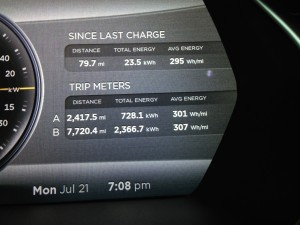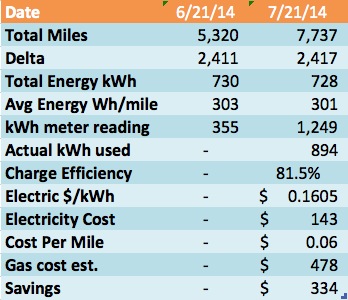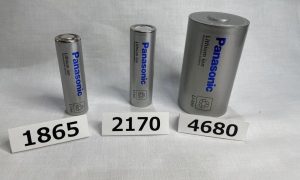Lifestyle
Charging a Tesla Model S Might Be Costing More Than You Think

 When you fill up a normal ICE car you know exactly what your costs are for the fuel. With an electric vehicle it is not that simple. There is a charging efficiency factor that comes into play which means that the reported amount of energy used could be understated and lower than the actual energy used. In a previous post I wrote about installing an EKM Digital Submeter on my NEMA 14-50 outlet to measure actual power usage of the Model S against the reported power displayed on the driver’s digital dash display. A month later and armed with more data, the energy loss I’m seeing is larger than I had originally expected.
When you fill up a normal ICE car you know exactly what your costs are for the fuel. With an electric vehicle it is not that simple. There is a charging efficiency factor that comes into play which means that the reported amount of energy used could be understated and lower than the actual energy used. In a previous post I wrote about installing an EKM Digital Submeter on my NEMA 14-50 outlet to measure actual power usage of the Model S against the reported power displayed on the driver’s digital dash display. A month later and armed with more data, the energy loss I’m seeing is larger than I had originally expected.
Test Setup
I charge at home 99% of the time and in the last three months I’ve logged 7,500+ miles driven, one trip to the Supercharger and two visits to the Tesla store’s High Power Wall Connector. I have a professionally installed NEMA 14-50 outlet at home. I’m using the factory supplied Universal Mobile Connector (UMC) as the cable between the outlet and the car. An EKM digital sub meter measures actual draw from the outlet and is accurate to within 1% and does not add any measurable load of its own.
Methodology
On the “anniversary date” of taking delivery of my Model S I recorded all of the pertinent info that was displayed before resetting the Trip A meter. Before driving the next day I record the reading on the EKM meter. That way I’ve got the mileage and the Tesla reported power usage over the period driven. This process will let me see a bunch of information that I plan on tracking over time, as follows:
- Monthly miles driven
- Monthly kWh used as reported by the Model S
- Monthly kWh used as reported by the EKM meter
- Monthly Average energy used
I plan on using this information to look at how average energy used changes as the months/temperature changes and perhaps as the Model S gets more miles on it. While I don’t drive consistently on any given day (test drives, special trips and the like), the numbers will average out and my driving style is not likely to change much after 30 years of driving (yeah I’m getting old but the Model S makes me feel young again!). I also drive pretty consistent patterns of commuting with a lot of miles to the same places which helps average out the special trips to locations with different terrain/conditions. Basically, while the conditions aren’t perfectly stable over time, the averages and data from this real world testing will be pretty accurate.
The Data
The last period (6/21 – 7/21) was my first full period with both the car and the EKM meter. A month of driving and charging, especially with the miles and kWh’s involved is a decent period over which to look at the results versus the 2 days from my prior blog post. Here’s the data:  In the above table you can see that the Model S reported 728 kWh used during the period but the meter reported 894 kWh used. This means my charging efficiency is only about 82% and electric usage (and cost) is 23% higher than I may have expected based on the readings the Model S provides. For that month this is an extra $26 of charging cost which is a small number but a notable percentage of the total. The good news is that even using this larger kWh number, the savings versus driving my old ICE car for energy alone comes in at $334 — I’m saving $334/month in gas driving my Model S!
In the above table you can see that the Model S reported 728 kWh used during the period but the meter reported 894 kWh used. This means my charging efficiency is only about 82% and electric usage (and cost) is 23% higher than I may have expected based on the readings the Model S provides. For that month this is an extra $26 of charging cost which is a small number but a notable percentage of the total. The good news is that even using this larger kWh number, the savings versus driving my old ICE car for energy alone comes in at $334 — I’m saving $334/month in gas driving my Model S!
Summary
Lifestyle
EV fans urge Tesla to acquire Unplugged Performance for edge in fleet and security industry
Unplugged Performance has built a name for itself by producing performance upgrades for Tesla vehicles.

A growing number of Tesla enthusiasts and longtime community voices are calling on the electric vehicle maker to acquire Unplugged Performance, a California-based aftermarket company best known for tuning Tesla vehicles and developing specialized government fleet solutions under its UP.FIT division.
The idea was once considered a niche proposal among EV fans, but it is now gaining serious attention not just as a performance play but as a strategic move to deepen Tesla’s roots in the fleet and security industry.
A strategic fit
Unplugged Performance has built a name for itself by producing performance upgrades for Tesla vehicles, from track-optimized components to visual and aerodynamic upgrades. But in recent years, its UP.FIT division has pivoted toward a more functional future by outfitting Tesla vehicles like Model Ys for police, military, and government use.
That work has sparked growing calls for closer collaboration with Tesla, especially as the EV maker increasingly leans into autonomy, AI, and fleet services as core components of its next chapter.
“I posted this four years ago, but I think it’s more true now than ever,” wrote Whole Mars Catalog, a well-known Tesla investor and FSD Beta tester, on X. “Tesla should buy Unplugged. But not just as a Performance division. What they are doing with UP.FIT unlocks large government and commercial fleet purchases that can improve utilization.”
Tesla fans such as shareholder Sawyer Merritt echoed the sentiment, calling Unplugged a “great fit within Tesla.” adding, “They are literally located directly next to Tesla’s design studio in Hawthorne.”
Enabling the next wave
Supporters of the idea noted that integrating Unplugged into Tesla’s corporate structure could help accelerate the adoption of autonomous technologies in government sectors. With UP.FIT patrol cars already in use across some U.S. police departments, Tesla fans envisioned a future where self-driving Teslas could potentially revolutionize law enforcement, search-and-rescue, and public service logistics.
“Just imagine how autonomous patrol cars could transform policing and bring us into a safer future,” the veteran FSD tester wrote.
The benefits could also extend to Tesla’s existing consumer base. “They also have some incredible products in the works that I think will appeal to many ordinary Tesla drivers — not just those looking for performance or mods. Stuff that’s so good it should have come straight from the design studio next door,” Whole Mars Catalog noted.
Unplugged Performance, founded in 2013, shares not just a product vision with Tesla, but also geography. Its Hawthorne headquarters sits directly adjacent to Tesla’s design studio, and the two companies have maintained a close working relationship over the years. The aftermarket firm has long positioned itself as a “mission-aligned” partner to Tesla.
In response to the recent calls for acquisition, Unplugged Performance acknowledged the support from the community. “Our very existence is to support the Tesla mission with @UpfitTesla and @UnpluggedTesla,” Unplugged CEO Ben Schaffer posted on X. “We love working with Tesla and are grateful for the community’s support since 2013!”
Elon Musk
X account with 184 followers inadvertently saves US space program amid Musk-Trump row
Needless to say, the X user has far more than 184 followers today after his level-headed feat.

An X user with 184 followers has become the unlikely hero of the United States’ space program by effectively de-escalating a row between SpaceX CEO Elon Musk and President Donald Trump on social media.
Needless to say, the X user has far more than 184 followers today after his level-headed feat.
A Near Fall
During Elon Musk and Donald Trump’s fallout last week, the U.S. President stated in a post on Truth Social that a good way for the United States government to save money would be to terminate subsidies and contracts from the CEO’s companies. Musk responded to Trump’s post by stating that SpaceX will start decommissioning its Dragon spacecraft immediately.
Musk’s comment was received with shock among the space community, partly because the U.S. space program is currently reliant on SpaceX to send supplies and astronauts to the International Space Station (ISS). Without Dragon, the United States will likely have to utilize Russia’s Soyuz for the same services—at a significantly higher price.
X User to the Rescue
It was evident among X users that Musk’s comments about Dragon being decommissioned were posted while emotions were high. It was then no surprise that an X account with 184 followers, @Fab25june, commented on Musk’s post, urging the CEO to rethink his decision. “This is a shame this back and forth. You are both better than this. Cool off and take a step back for a couple days,” the X user wrote in a reply.
Much to the social media platform’s surprise, Musk responded to the user. Even more surprising, the CEO stated that SpaceX would not be decommissioning Dragon after all. “Good advice. Ok, we won’t decommission Dragon,” Musk wrote in a post on X.
Not Planned, But Welcomed
The X user’s comment and Musk’s response were received extremely well by social media users, many of whom noted that @Fab25june’s X comment effectively saved the U.S. space program. In a follow-up comment, the X user, who has over 9,100 followers as of writing, stated that he did not really plan on being a mediator between Musk and Trump.
“Elon Musk replied to me. Somehow, I became the accidental peace broker between two billionaires. I didn’t plan this. I was just being me. Two great minds can do wonders. Sometimes, all it takes is a breather. Grateful for every like, DM, and new follow. Life’s weird. The internet’s weirder. Let’s ride. (Manifesting peace… and maybe a Model Y.)” the X user wrote.
Lifestyle
Tesla Cybertruck takes a bump from epic failing Dodge Charger
The Cybertruck seemed unharmed by the charging Charger.

There comes a time in a driver’s life when one is faced with one’s limitations. For the driver of a Dodge Charger, this time came when he lost control and crashed into a Tesla Cybertruck–an absolute epic fail.
A video of the rather unfortunate incident was shared on the r/TeslaLounge subreddit.
Charging Charger Fails
As could be seen in the video, which was posted on the subreddit by Model Y owner u/Hammer_of_something, a group of teens in a Dodge Charger decided to do some burnouts at a Tesla Supercharger. Unfortunately, the driver of the Charger failed in his burnout or donut attempt, resulting in the mopar sedan going over a curb and bumping a charging Cybertruck.
Ironically, the Dodge Charger seemed to have been parked at a Supercharger stall before its driver decided to perform the failed stunt. This suggests that the vehicle was likely ICE-ing a charging stall before it had its epic fail moment. Amusingly enough, the subreddit member noted that the Cybertruck did not seem like it took any damage at all despite its bump. The Charger, however, seemed like it ran into some trouble after crashing into the truck.
Alleged Aftermath
As per the the r/TeslaLounge subreddit member, the Cybertruck owner came rushing out to his vehicle after the Dodge Charger crashed into it. The Model Y owner then sent over the full video of the incident, which clearly showed the Charger attempting a burnout, failing, and bumping into the Cybertruck. The Cybertruck owner likely appreciated the video, in part because it showed the driver of the Dodge Charger absolutely freaking out after the incident.
The Cybertruck is not an impregnable vehicle, but it can take bumps pretty well thanks to its thick stainless steel body. Based on this video, it appears that the Cybertruck can even take bumps from a charging Charger, all while chilling and charging at a Supercharger. As for the teens in the Dodge, they likely had to provide a long explanation to authorities after the incident, since the cops were called to the location.
-

 Elon Musk2 weeks ago
Elon Musk2 weeks agoTesla investors will be shocked by Jim Cramer’s latest assessment
-

 News2 days ago
News2 days agoTesla debuts hands-free Grok AI with update 2025.26: What you need to know
-

 Elon Musk4 days ago
Elon Musk4 days agoxAI launches Grok 4 with new $300/month SuperGrok Heavy subscription
-

 Elon Musk7 days ago
Elon Musk7 days agoElon Musk confirms Grok 4 launch on July 9 with livestream event
-

 News1 week ago
News1 week agoTesla Model 3 ranks as the safest new car in Europe for 2025, per Euro NCAP tests
-

 Elon Musk2 weeks ago
Elon Musk2 weeks agoxAI’s Memphis data center receives air permit despite community criticism
-

 News4 days ago
News4 days agoTesla begins Robotaxi certification push in Arizona: report
-

 News2 weeks ago
News2 weeks agoTesla sees explosive sales growth in UK, Spain, and Netherlands in June



















